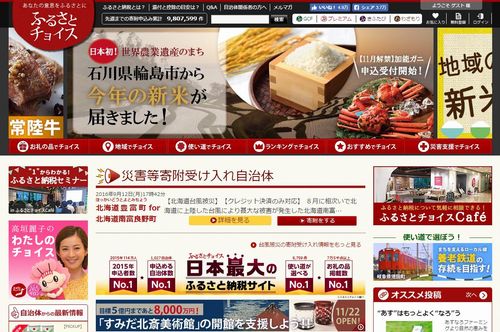September 19, 2016
Innovative 'Hometown Tax' Donation Program Supports Municipalities
Keywords: Money Newsletter Policy / Systems
JFS Newsletter No.168 (August 2016)
 Image by Japan for Sustainability.
Image by Japan for Sustainability.
Japan has a program in which Japanese citizens living anywhere can donate money to local governments that they want to support. This "Furusato Nozei" program (which literally means hometown tax payment) is gaining in popularity. Why is it so popular? Why is this program referred to as a tax, although it is actually a donation system? And what problems does it have? This newsletter article introduces the program.
Design of the Hometown Tax Program
Japan is facing a continuing population flow from rural areas to urban areas, because many people born and raised in rural areas are moving to urban areas for education or employment. The result is that urban municipalities with large populations can obtain stable tax revenues, while municipalities in rural areas cannot secure sufficient tax revenues due to their declining population levels. The hometown tax program was established based on the idea that people should be able to pay tax not only to municipalities where they live but also to their "furusato" (which literally means hometown). In reality, it is difficult to precisely define the meaning of furusato, so the program was designed to cover not only the place where a person actually comes from but also any other local government (meaning both prefectures and municipalities). The program was launched in May 2008.
Here is how the program works. For instance, if Mr. A, who lives in City B in Tokyo, donates 30,000 yen (about U.S.$286) to Town C (where he comes from or wants to support), this amount of money goes to Town C. Meanwhile, he is eligible for a deduction of 28,000 yen (2,000 yen is subtracted from the donated 30,000 yen) from his taxes otherwise to be paid to City B where he lives. (There is an upper limit for donations qualified for deduction, depending to the donors' income, family structure, etc.) Not only that, many local governments send donors local specialty products in return for their donation, such as beef, crab, melon, and other expensive products. In this way, if people make a donation to a local government, they will be eligible for a tax deduction and also receive a reward gift. That is the reason why the program is gaining popularity.
The Japanese government is also advancing measures to promote the program. For instance, in 2015, it roughly doubled the limit of complete tax credits for donations, and also simplified the system for claiming the tax deduction. For this reason, the total amount of donations that local governments received under this program increased by a factor of approximately 20, from about 8.1 billion yen ($77 million) in 2008, the year when the program was launched, to about 165 billion yen ($1.57 billion) in 2015.
How Donations Are Used
Each municipality participating in this program utilizes donations in various ways. Let's take the example of Kamishihoro Town, whose population is about 5,000, in the northernmost island prefecture of Hokkaido. The town received over 1.5 billion yen (about $14.29 million) in donations in total through this program in fiscal 2015 (reward gifts include homegrown wagyu beef and ice cream products), while total annual revenue from local taxes, including the municipal residence tax, was about 600 million yen (about $5.71 million). The town used part of the donations for its "Dream Fund for Child-rearing and Measures against the Declining Birthrate," and announced that it provides free services at an early childhood education and care center ("Kodomo-en") certified by the town for ten years, starting from fiscal 2016. The reward gifts also help improve the branding of the town's local products.
Some prefectures and municipalities utilize the donations to preserve local nature, history, and culture. For instance, Ashikaga City in Tochigi Prefecture northeast of Tokyo, allows contributors to choose from several options in different areas, including "education and culture" and "civic and welfare activities," for their donations to be used. One of the options is the renovation of Ashikaga Gakko (school), which is said to be the oldest academic institution in Japan. Also, Hiroshima City, in Hiroshima Prefecture, announced that it would use donations for the preservation of buildings that survived the atomic bomb dropped there in World War II.
The hometown tax program is also getting much attention as a means to support areas affected by major disasters. According to a comprehensive portal site for the program named "Furusato Choice," as of August 7, 2016, a total of over 1.4 billion yen (about $13.33 million) was donated for relief activities in Kumamoto Prefecture, which was hit by big earthquakes in March of the same year. In general, reward gifts are not offered to those who opted for donating money specifically for supporting disaster-hit areas. In addition, many of those who donated money to Kumamoto Prefecture through the program declined to receive reward gifts from the prefecture.

Furusato Choice:
http://www.furusato-tax.jp/ (Only in Japanese)
Emerging Issues
As the program caught on and the amount of donations got bigger, various issues surfaced, three of which are explained below.
The first issue is that reward gifts are becoming expensive. Prefectures and municipalities tend to offer more expensive reward gifts, since premium gifts tend to attract more donors. Some data shows that half of the total amount donated through the program nationwide is spent on the cost to purchase and send reward gifts. Many websites and publications now showcase reward gifts from different local governments, so people tend to donate money with an eye to benefiting from the reward gifts rather than supporting local areas. In addition, some local governments offer home appliances and other products as reward gifts that have nothing to do with local products. Also, in some cases, "Hometown Appreciation Coupons," which can supposedly only be used in shops and restaurants within the municipality that issued them as reward gifts, have been cashed via online auction sites. Some critics say that these situations reveal that the program is becoming inconsistent with the original intent of supporting hometowns.
The second issue is that some local governments are recording a deficit with the program, while some are enjoying a surplus, calculated from the difference between the total revenue raised from donations and the total tax deductions incurred. Municipalities with a deficit are mainly urban cities. In fiscal 2014, for example, the municipalities with a deficit included Yokohama City (Japan's second most populous city, just south of Tokyo), with a deficit of about 520 million yen (about $4.95 million), Setagaya Ward in Tokyo with about 310 million yen (about $2.95 million), and Minato Ward in Tokyo with about 280 million yen (about $2.67 million), according to an article in the morning edition of the Asahi Shimbun newspaper on April 13, 2016.
The reason many municipalities in the red are in urban areas is that all or part of residence taxes and other taxes of people in urban areas who paid hometown taxes to municipalities in rural areas are tax-deductible, and as a result, tax revenues of such municipalities in urban areas decrease. The hometown tax program was established to allocate to rural municipalities part of the taxes paid to urban municipalities, but any deficit is a headache for the latter. For example, the deficit of Setagaya Ward increased from approximately 300 million yen (about $2,857,000) in fiscal 2014 to approximately 600 million yen (about $5,714,000) in fiscal 2015 (figures from Asahi Shimbun article mentioned above.)
The third problem is also connected to the deficits in urban municipalities. As mentioned in the description above, the amount that a person donated using the hometown tax program minus 2,000 yen is deducted from residence taxes and other taxes. An upper limit is set on the tax-deductible donation according to income, family composition, and other conditions; and the higher the income, the higher the tax-deductible amount.
An estimate released by the Ministry of Internal Affairs and Communications (MIAC) for the fully deductible hometown tax amount (annual upper limit) shows that up to 11,000 yen (about $105) is deductible for a household with two parents and a high school student if annual household income is three million yen (about $28,600), but the figure jumps to 818,000 yen (about $7,800) if the family's annual household income is 25 million yen (about $238,000).
Some people criticize the hometown tax program, saying that high-income earners take advantage of the program as a tax-saving measure through which they receive reward gifts. Some websites even offer to consolidate reward gifts they say can be earned by "donations" exceeding a million yen (about $9,500).
New Developments
The hometown tax program is still evolving. Responding to the criticism that the value of reward gifts continued to rise, in April 2016 the MIAC issued an advisory to local governments to the effect that local governments should not indicate the prices of reward gifts and should not offer electrical appliances, prepaid cards, or other negotiable products, since the hometown tax is a donation from which donors are not supposed to seek profits. This advisory is legally unenforceable, so we need to observe what rules will be set up in the future.
Meanwhile, in fiscal 2016, a corporate version of the hometown tax program was launched. In this program, companies are eligible for a tax reduction of approximately 60 percent of the value of donations made for municipal or prefectural projects certified by the government as contributing to local revitalization. For example, if a company donates 10 million yen (about $95,200), its tax burden is reduced by approximately six million yen (about $57,120). In contrast to the tax program for individuals, the prefectures and municipalities that receive donations through the corporate program are not permitted to offer reward gifts, because of the concern that giving reward gifts may lead to unlawful behavior.
The hometown tax program is an idea that is still evolving. We will be watching to see whether or not it leads to regional revitalization in Japan while maintaining its principle of supporting rural areas and hometowns.
Written by Naoko Niitsu
Related
"JFS Newsletter"
- 'Good Companies in Japan' (Article No.4): 'Eightfold Satisfaction' Management for Everyone's Happiness
- "Nai-Mono-Wa-Nai": Ama Town's Concept of Sufficiency and Message to the World
- 'Yumekaze' Wind Turbine Project Connects Metro Consumers and Regional Producers: Seikatsu Club Consumers' Co-operative
- Shaping Japan's Energy toward 2050 Participating in the Round Table for Studying Energy Situations
- 'Good Companies in Japan' (Article No.3): Seeking Ways to Develop Societal Contribution along with Core Businesses


